The Nymph's Reply to the Shepherd100首英语爱情诗迻译(四十二)
The Passionate Shepherd to His Love
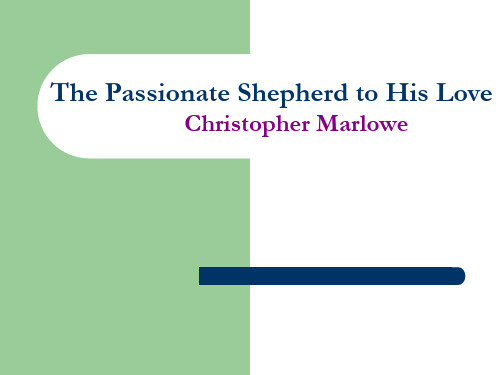
Theme of the Poem
The theme of “The Passionate Shepherd to His Love” is the rapture of springtime love in a simple, rural setting. Implicit in this theme is the motif of capere die—Latin for “seize the day.” Capere die urges people to enjoy the moment without worrying about the future.
The Passionate Shepherd to His Love
Christopher Marlowe
The Passionate Shepherd to His Love
Introduction of the Author About the Poem Itself Type of the Poem Characters in the Poem Theme of the Poem The Poem’s Enduring Emotional Appeal
About the Poem Itself
Fits perfectly into the poetic genre Publication in 1599 in England One of the earliest examples of the pastoral style of British poetry in the late Renaissance period Used for scholastic purposes A good example of regular meter and rhythm The Nymph’s Reply to the Shepherd written by Sir Walter Raleigh
Sir_Walter_Raleigh
• • • • • • • •
But could youth last, and love still breed, Had joys no date, nor age no need, Then these delights my mind might move To live with thee, and be thy love. 可只要青春常在,爱能得到滋润 只要愉悦无穷,岁月永恒 这样的欢乐就会打动我的心房 来和你一起生活做你的新娘.
The Nymph’s Reply to the Shepherd 仙女对牧羊人的回答
• 这首诗是raleigh回敬marlowe的那首The Passionate Shepherd to His Love.这里呀, releigh可是吧marlowe大大的嘲讽了一番呢, 意在说他脱离现实生活,之前marlowez在 诗里呼唤仙女与他共享山林鲜花,而人家 raleigh说了这些都Soon break,soon wither soon forgetten!转瞬即逝的东西。人家要 的是精神上的契合嘛。人家要 youth last,love still breed ,Had joys no date ,nor age no need!完了吧,Marlowe 被华丽丽的讽刺了
• • • • • • • •
The flowers do fade, and wanton fields, To wayward winter reckoning yields, A honey tongue, a heart of gall, Is fancy’s spring, but sorrow’s fall. 花儿回凋落,诱人的田野也一样 屈从于冬天,它的变幻无常 甜蜜的舌头,一颗冷酷的心 是幻想的喷泉,却把痛苦降临
-英语文体学
Assonance
Rhyming of vowels in a line
How sad and bad and mad it was – But then, how it was sweet!
About Metre (Rhythm)
Six basic metrical feet: iamb x / trochee / x anapest x x / dactyle / x x spondee / / pyrrhic x x
My Heart's In The Highlands
Robert Burns (1759 -1796)
My heart's in the Highlands, my heart is not here, My heart's in the Highlands a-chasing the deer – A-chasing the wild deer, and following the roe; My heart's in the Highlands, wherever I go.
Exposure
Wilfred Owen (1893 -1918)
关于一战,我们了解多少?
Our brains ache, in the merciless iced east winds that knive us... Wearied we keep awake because the night is silent... Low, drooping flares confuse our memory of the salient... Worried by silence, sentries whisper, curious, nervous, But nothing happens.
The Nymph's Reply to the Shepherd 100首英美爱情诗迻译 (2)
The Nymph's Reply to the Shepherd 100首英美爱情诗迻译(2)诗人简介克里斯托弗·马洛Christopher Marlowe(1564—1593),英国诗人,剧作家。
在剑桥大学获硕士学位。
马洛革新了中世纪的戏剧,共写了七部剧本,其中塑造的时代巨人形象及其无韵体诗剧形式对莎士比亚等作家产生了很大影响,是英国近代戏剧的奠基者。
他翻译了三卷奥维德的《爱情诗》,写了少量抒情短诗。
可惜这一巨匠却英年早逝于一场酒吧斗殴。
无婚史。
诗歌选辑The Passionate Shepherd to His loveCome live with me and be my love,And we will all the pleasures proveThat valleys, groves, hills, and fieldsWoods, or steepy mountain yields.And we will sit upon the rocks,Seeing the shepherds feed their flocks,By shallow rivers to whose fallsMelodious birds sing madrigals.And I will make thee beds of rosesAnd a thousand fragrant posies,A cap of flowers, and a kirtleEmbroidered all with leaves of myrtle;A gown made of the finest woolWhich from our pretty lambs we pull;Fair lined slippers for the cold,With buckles of the purest gold;A belt of straw and ivy buds,With coral clasps and amber studs:And if these pleasures may thee move ,Come live with me and be my love.The shepherds’ swains shall dance and singFor thy delight each May morning:If these delights thy mind may move,Then live with me and be my love.__________________________________________________________注释1.And we will all the pleasures prove ...yields: And we will prove all the pleasures that valleys...yields( brings about).生产;获利2. falls:瀑布;落下,此处指溪水流淌中形成的水落。
the passionate shepherd to his love
The Passionate Shepherd to His Loveby Christopher MarloweCome live with me and to be my loveAnd we will all the pleasure proveThat valleys, groves, hills, and fields, Woods, or steepy mountain yields.And we will sit upon the rocks,Seeing the shepherds feed their flocks,By shallow rivers to whose fallsMelodious birds sing madrigals.And I will make thee beds of rosesAnd a thousand fragrant posies,A cap of flowers, and a kirtle Embroidered all with leaves of myrtle;A gown made of the finest woolWhich from our pretty lambs we pull;Fair lined slippers for the cold,With buckles of the purest gold;A belt of straw and ivy buds,With coral clasps and amber studs:And if these pleasures may thee move, Come live with me, and be my love.The shepherds’ swains shall dance and sing For thy delight each May morning:If these delights thy mind may move,Then live with me and be my love.激情的牧人致心爱的姑娘来与我同住吧,做我的爱人,我们将共享一切欢乐;来自河谷、树丛、山岳、田野,来自森林或陡峭的峻岭。
关于美丽的英文诗歌欣赏

关于美丽的英文诗歌欣赏英语诗歌是英国文学的精粹,更是世界文学的瑰宝,集中体现了诗歌形式美与非形式美的高度统一并传递了诗歌的美学价值,给人以音乐美、视觉美、意象美。
小编精心收集了关于美丽的英文诗歌,供大家欣赏学习!关于美丽的英文诗歌篇1The Philosopher in Floridaby C. Dale YoungMidsummer lies on this townlike a plague: locusts now replacedby humidity, the bloodied Nilenow an algae-covered rivuletstruggling to find its terminus.Our choice is a simple one:to leave or to remain, to renderthe Spanish moss a memoryor to pull it from trees, repeatedly.And this must be what the youngphilosopher felt, the pull of a dialectic so basicthe mind refuses, normally,to take much notice of it.Outside, beyond a palm-tree fence,a flock of ibis mounts the air,our concerns ignoredby their quick white wings.Feathered flashes reflected in water,the bending necks of the cattails:the landscape feels nothing——it repeats itself with or without us.关于美丽的英文诗歌篇2Cement Guitarby Michael CarlsonAll morning I've remembered St. Ignacio's bruise,jaundiced seagulls over Quonset, Novemberand the gross white sky. Days so longyou walk home fifteen miles from the restaurant.Same waitress every day of your lifeand she never remembers your allergies.Nothing on the map but scone crumbsand a drop of tea. Just manifold food and a dead requestto bury the last of your seven receipts.Mother of foster-wit, father of straw,I can see how silence takes the place of thosewho cut their thoughts in stone before they need them.Stone is the past, and the past is a form of flattery.Last winter, groups of children sent lettersin sadness for the late Christmas suicide.Addressed to those who managed the fishery,who named the docks and decided the colors of unfinished boats,the only way to read them was alive.To think out loud about those children's nameswas to forget what you meant by dying.关于美丽的英文诗歌篇3Butterfly Catcherby Tina CaneIn the SixtiesNabokov switchedfrom ink to eraser-topped pencilon index cards a boxof cards for Ada a boxof cards for dreamswhose "curious features"include "erotic tendernessand heart-rending enchantment"in one drafthe traded "stillness and heat"for "silence, a burning"so picture:Vladimir seatedat the trunk of a treea spring dayat Wellesley wherehe marvels at his studentsand their cable-knit socksthe way each elasticgrips without bindingjust belowthe knee so exquisitean application of pressurethat when said sockis slowlypeeled offthe skin showsno trace at all关于美丽的英文诗歌篇4The Nymph's Reply to the Shepherdby Sir Walter RaleghIf all the world and love were young,And truth in every shepherd's tongue,These pretty pleasures might me moveTo live with thee and be thy love.Time drives the flocks from field to fold When rivers rage and rocks grow cold,And Philomel becometh dumb;The rest complains of cares to come.The flowers do fade, and wanton fieldsTo wayward winter reckoning yields;A honey tongue, a heart of gall,Is fancy's spring, but sorrow's fall.Thy gowns, thy shoes, thy beds of roses,Thy cap, thy kirtle, and thy posiesSoon break, soon wither, soon forgotten——In folly ripe, in reason rotten.Thy belt of straw and ivy buds,Thy coral clasps and amber studs,All these in me no means can moveTo come to thee and be thy love.But could youth last and love still breed,Had joys no date nor age no need,Then these delights my mind might moveTo live with thee and be thy love.。
“The-Nymph’s-Reply-to-the-Shepherd”and-Marlowe’s-“
“T h e-N y m p h’s-R e p l y-t o-t h e-S h e p h e r d”a n d-M a r l o w e’s-“T h e-P a s s i o n a t e-S h e p h e r d-t o-H i s-L o v e.”(共11页)-本页仅作为预览文档封面,使用时请删除本页-the passionate shepherd to his love.madrigals were highly popular in England and elsewhere in Europe. However, the poem could be about any shepherd of any age in any country, for such is the universality of its theme.CharactersThe Passionate Shepherd: He importunes a woman—presumably a young and pretty country girl—to becomehis sweetheart and enjoy with him all the pleasuresthat nature has to offer.The Shepherd’s Love: The young woman who receives the Passionate Shepherd’s message.Swains: Young country fellows whom the Passionate Shepherd promises will dance for his beloved.Theme.......The theme of “The Passionate Shepherd” is the rapture of springtime love in a simple, rural setting. Implicit in this theme is the motif of carpe diem—Latin for “seize the day.” Carpe diem urges people to enjoy the moment without worrying about the future.Writing and Publication Information.......Marlowe wrote the poem in 1588 or 1589 while attending Cambridge University at its Corpus Christi College. It first appeared in print in poetry collections published in 1599 and 1600.Meter.......The meter is iambic tetrameter, with eight syllables (four iambic feet) per line. (An iambic foot consists of an unstressed syllable followed by a stressed syllable.) The following graphic presentation illustrates the meter of the first stanza.........1................2...............3 (4)Come LIVE..|..with ME..|..and BE..|..my LOVE,......1...............2...............3 (4)And WE..|..will ALL..|..the PLEA..|..sures PROVE........1.................2..................3. (4)That HILLS..|..and VALL..|..eys, DALE..|..and FIELD,......1..................2.................3.. (4)And ALL..|..the CRAG..|..gy MOUNT..|..ains YIELD.Rhyme.......In each stanza, the first line rhymes with the second, and the third rhymes with the fourth.Structure.......The poem contains seven quatrains (four-line stanzas) for a total of twenty-eight lines. Marlowe structures the poem as follows:Stanza 1:......The shepherd asks the young lady to "live with me and be my love," noting that they will enjoy all the pleasures of nature.Stanzas 2-4: The shepherd makes promises that he hopes will persuade the young lady to accept his proposal.Stanzas 5-7: After making additional promises, the shepherd twice more asks the lady to "live with me and be my love.".The Passionate Shepherd to His LoveBy Christopher MarloweCome live with me and be my Love,And we will all the pleasures prove1That hills and valleys, dale and field,And all the craggy mountains yield.There will we sit upon therocks (5)And see the shepherds feed their flocks, By shallow rivers, to whose falls Melodious birds singThere will I make thee beds of rosesAnd a thousand fragrant posies, (10)A cap of flowers, and a kirtle3 Embroider'd all with leaves ofA gown made of the finest woolWhich from our pretty lambs we pull,Fair linèd slippers for the cold, (15)With buckles of the purest gold.A belt of straw and ivy budsWith coral5 clasps and amber6 studs: And if these pleasures may thee move,Come live with me and be my Love (20)Thy silver dishes for thy meatAs precious as the gods do eat,Shall on an ivory table bePrepared each day for thee and me.The shepherd swains7 shall dance andsing (25)For thy delight each May-morning:If these delights thy mind may move,Then live with me and be my Love.Notes1...prove: test, try out2...madrigals: poems set to music and sungby two to six voices with.....a single melody or interweavingmelodies3...kirtle: dress or skirt4...myrtle: shrub with evergreen leaves,white or pink flowers, and dark.....berries. In Greek mythology, a symbolof love.5...coral: yellowish red;6...amber: yellow or brownish yellow7...swains: country youths....Figures of Speech.......Following are examples of figures of speech in the poem. AlliterationLine 2: And we will all the pleasures prove10 Step Poetry Explication Process1) TitleA nymph's reply to a statement made by a shepherd.2)Dramatic SitutaionSpeaker is the nymph (the young girl)The addressee is the shepherd3)SubjectThe nymph is responding to the proposal made by the shepherd. She contrasts the hypothetical world presented by the shepherd with reality. The nymph says that what makes the shepeherd's vision false is time and attacks his assumption that love and lovers will remain young.4) Images, Figures of Speech, Literary DevicesRaleigh uses the poetic devices that give Marowe's poem it's musicality. (as mockery)*alliteration- ex: "flocks from field to fold"*repition of intial consonant sounds- ex: "flowers" and "fade", "wayward" and "winter", "spring" and "sorrow", "fancy" and "fall"5) ToneRealisticIn Stanza 6 the tone changes to wishful with the word "but".The nymp wished the world could be immortal.6) Structurial DivisionsSix four line stanza containing two rhymed coupletsPredominant meter is iambic tetrameterex: If all/ the world/ and love/ were young...The speaker contasts the shepherd's vision with realities introduced by the word "but" -Point by point shows how everything withers and dies.****Parody-parallels The Passionate Shepherd to His Love in both form and contentRejects shepherd by stanza 5- "All these in me no means can move"In Stanza 6 a twist occurs. She says if the world were as the shepherd has promised.7) Rhyme Schemeaabb ccdd eeff gghh iibb jjbb8) TitleThe nymph's reply to the promises made by the shepherd9) ThemeThe poem is centrally concerned with responding to theinvitation by the Shepherd in The Passionate Shepherd to His Love.The poet wishes to addressee to know that his promises are not possible because time changes them.10) DictionFormal- ex: "thee", "thy"Connotative- The images are real, but are taken from the Passionate Shepherd to His love, and go beyond their meaning. The effect of time on these objects is representative of all change.Concrete- The words are specific and give a mental pictureex: "coral claps", "rivers rage"Cacophonous-ex: "rage", "gall", "sorrow", "forgotten", "rotten"Although there are many pleasant sounding words in the poem they are all dervied from the shepherd's promises.Share“The Nymph’s Reply to the Shepherd” is Sir Walter Raleigh’s response to a poem written by Christopher Marlowe, “The Passionate Shepherd to His Love.” In the Marlowe poem, the shepherd proposes to his beloved by portraying their ideal future together: a life filled wit h earthly pleasures in a world of eternal spring. Raleigh’s reply, however, debunks the shepherd’s fanciful vision. While Marlowe’s speaker promises nature’s beauty and a litany of gifts, Raleigh’s nymph responds that such promises could only remain valid “if all the world and love were young.” Thus, she introduces the concepts of time and change. In her world, the seasons cause the shepherd’s “shallow rivers” to “rage,” rocks to “grow cold” and roses to “fade.” The shepherd’s gifts might be desirable, but they too are transient: they “soon break, soon wither” and are “soon forgotten.” In the end, the nymph acknowledges that she would accept the shepherd’s offer “could youth last” and “had joys no date.” Like the shepherd, she longs for such things to be tru e, but like Raleigh, she is a skeptic, retaining faith only in reason’spower to discount the “folly” of “fancy’s spring.”"The Nymph's Reply to the Shepherd" was written by Sir Walter Raleigh in response to Christopher Marlowe's "The Passionate Shepherd to His Love". It could be considered a criticism, or atleast a negative reaction to the original poem, as the nymph is in fact rejecting the shepherd in question quite harshly, and includes many lines that are directly connected to propositions made in Marlowe's poem. Others read the poem as a critique of the entire pastoral convention, suggesting through its use of Philomel that women are denied a voice in the traditional literature. The last stanza, "But could youth last, and love still breed,/ Had joys no date, nor age no need,/ Then these delights my mind might move/ To live with thee and be thy love," suggests either that the nymph's rejection of the shepherd is related to her own feelings of mortality and the transience of life, or acceptance is predicated upon the impossible and, therefore,Raleigh's poem "The Nymph's Reply to the Shepherd" is a witty and well-written reply to Marlowe's more innocent "The Passionate Shepherd to His Love". Using similar images and metrics, Raleigh cleverly presents the nymph's world-weary response to the shepherd's new and childlike view of love.In Marlowe's poem, the shepherd reaches out to his love with a pastoral ballad. The piece is very beautiful, painting an idyllic scene wherein the shepherd and his love can roam at their will. The shepherd tells his love that he will give all for her if she would just live with him; together they will "all the pleasures prove" (2) and he would show her to a world where birds sing, the sun shines, and everything is serene and perfect. Even Marlowe's use of language contributes to his scene of happiness with which he tries to lure his love; the poem is written in iambic tetrameter couplets, giving it a lilting and song-like feel. He also employs alliteration quite often and to great effect; soft, rolling sounds like "we will" (2), "mind may move" (27), and "live with me and be my Love" (28) achieve a verbal approximation of the valleys and hills that he speaks of contextually.Pastoral lyric: Poetry that expresses emotions in an idyllic setting. It is related to the term "pasture," and is associated with shepherds writing music to their flocks. The tradition goes back to David in the Bible and Hesiod the Greek poet.The themes of the poem - carpe diem and the immediate gratification of their sexual passions.Love in the May countryside will be like a return to the Garden of Eden. There is a tradition that our problems are caused by having too many restrictions, by society. If we could get away from these rules, we could return to a prisitine condition of happiness. The "free love" movement of the 1960's was a recent manifestation of this utopian belief. If the nymph would go a-maying with the shepherd, they would have a perfect life.In quatrains (4 line stanzas) of iambic tetrameter (8 syllables per line, 4 measures per line with 2 syllables in each measure), the shepherd invites his beloved to experience the joys of nature.He hopes to return with the nymph to a Edenic life of free love in nature.Notes for "The Nymph's Reply to the Shepherd."Raleigh argues that it is not society that taints sexual love. We are already tainted before we enter society. Releigh combines carpe diem with tempus fugit in an unusual way. Normally we should sieze the day because time flies. Raleigh argues that because time flies, we should NOT sieze the day. There will be consequences to their roll in the grass. Time does not stand still; winter inevitably follows the spring; therefore, we cannot act on impulses until we have examined the consequences.The world is NOT young--we are not in Eden, but in this old fallen world - a world in which shepherds have actually been known to lie to their nymphs.This poem by Sir Walter Raleigh uses the same meter and references to present "mirror images" of Marlowe's poem. The feminine persona (the nymph) of the poem sets up a hypothetical set of questions that undermine the intelligence of the man's offer because all that he offers is transitory. She reverses his images into negative ones:rocks grow coldfields yield to the harvestthe flocks are driven to fold in winterrivers ragebirds complain of winter (a reference to the story of Philomela who was raped and turned into a nightingale).We live in a fallen world. Free love in the grass in impossible now because the world is not in some eternal spring. The seasons pass, as does time. Nymphs grow old, and shepherds grow cold.In structure, “The Nymph’s Reply to the Shepherd” mimicsMarl owe’s “The Passionate Shepherd to His Love.” Like the latter poem, it consists of six four-line stanzas, or quatrains, with each stanza the fusion of two rhymed couplets. Also like Marlowe’s poem, the predominant meter of “The Nymph’s Reply to the Shepherd” is iambic tetrameter. This means each line contains four iambs, or two-syllable units of rhythm in which the first syllable is unstressed and the second is stressed. As an example of iambic tetrameter, consider the following line from the poem:...Raleigh's poem "The Nymph's Reply to the Shepherd" is a witty and well-written reply to Marlowe's more innocent "The Passionate Shepherd to His Love". Using similar images and metrics, Raleigh cleverly presents the nymph's world-weary response to the shepherd's new and childlike view of love.In Marlowe's poem, the shepherd reaches out to his love with a pastoral ballad. The piece is very beautiful, painting an idyllic scene wherein the shepherd and his love can roam at their will. The shepherd tells his love that he will give all for her if she would just live with him; together they will "all the pleasures prove" (2) and he would show her to a world where birds sing, the sun shines, and everything is serene and perfect. Even Marlowe's use of language contributes to his scene of happiness with which he tries to lure his love; the poem is written in iambic tetrameter couplets, giving it a lilting and song-like feel. He also employs alliteration quite often and to great effect; soft, rolling sounds like "we will" (2), "mind may move" (27), and "live with me and be my Love" (28) achieve averbal approximation of the valleys and hills that he speaks of contextually.Raleigh, however, will have none of Marlowe's idealism and naivet. In his poem, the shepherd has sung his song to the lover, and Raleigh's poem is her reply. Interestingly enough, Raleigh uses the word "nymph" instead of a more neutral word like "girl" or a direct counter like "love". Although the word nymph did mean "girl" in Raleigh's time, it also had the mythological connotation of a female spirit who would have been adept at warding off satyrs and would-be suitors. Raleigh's nymph breaks down the shepherd's love-struck ballad quickly and efficiently; in fact, Raleigh's poem has a counter for each of Marlowe's ideas. It begins by having the nymph doubt the shepherd's ability to make true his promises; she questions the "truth in every shepherd's tongue" (2). The shepherd and the nymph see the world in two very different lights: while the shepherd entreats the nymph to come with him, the nymph's response is one of sobering mortality. For all hisromantic ideas of fields and flowers, the nymph knows that it does not matter because eventually "Time drives the flocks from fields to fold" (5) and "flowers fade" (6). Where the shepherd's "birds sing madrigals" (8), the nymph replies that "Philomel becometh dumb" (7), invoking the mythological story of Philomela, a Greek girl who was transformed intoa nightingale. The poem continues in this tone until the last stanza; there, Raleigh's nymph concedes that if they were both immortal she might consider joining him, a last bit of hope for Marlowe's poor shepherd.The language of Raleigh's poem contributes greatly to the nymph's demolition of the shepherd's nave and heartfelt plea for love. Raleigh reiterates many of Marlowe's images and ideas, but distorts them through the lens of time. The same alliteration is also used in both; there is, however, a marked difference in their sounds. Marlowe alliterates softer "m" and "l" sounds, giving his poem the aforementioned rolling aspect. Raleigh imitates Marlowe extremelywell, but there is a telling difference that can be noted in some places; Raleigh uses a rougher alliteration of sounds like hard "c" and "t" to give his poem a more mocking, satirical bent. This is especially prominent in the second stanza of Raleigh's poem; while Marlowe's second stanza has the softer alliterative sounds, Raleigh's stanza moves stiffly with the "c" sounds in "complains of cares to come "(8).The metrics of Raleigh's poem are also in and of themselves a direct reply to Marlowe's. Raleigh uses the same iambic tetrameter that Marlowe uses, organizing the poem into four line stanzas composed of two rhyming couplets each. He achieves an oddly mocking tone with the meter because of the words involved. Although the words still flow because of the regular meter, they are decidedly less romantic andare juxtaposed with the meter. Examples of this are the harsh alliteration in "complains of cares to come" (8) or the rolling, soft sound that "wayward winter's reckoning yields" (10). Although the metrics are regular and fall soft on the ear, the subject matter is darker and uses the meter to make fun of Marlowe's pastoral love poem. Raleigh also uses metric substitution, like his alliteration, to make his poem rougher and less pleasing to the ear than Marlowe's.The first example of metric substitution comes in the second stanza. The two stressed feet in "Time drives" (5) are an abrupt break from the pleasing, flowing metrics that Marlowe established and Raleigh's first stanza adhered to. The spondee substitution has a forced sound that gives the reader the impression that time never ceases, relentlessly pressing on against the pleasures of which Marlowe's shepherd thinks so highly. It is also found in the second line where "rocks grow cold" (6). The substitution here is ironic because the verb "grow" is usually associated with natural things like trees and flowers, objects with which the shepherd tries to entice the nymph. The nymph, however, returns with an object that is rough and does not truly grow; she instead uses the word to mean "to turn", and the stresses indicate the harsh reality of the line.The second example of metrics is found in the fourth stanza, and itis an interesting thing indeed. Each line in the fourth stanza has nine syllables as opposed to eight, thus giving each line a feminine ending. This is interesting in that feminine endings are generally aweaker ending; however, it is clear in this stanza that the lines are powerful and reject the gifts the shepherd has offered. The thirdline of the stanza thunders into being, with four stressed syllables at the beginning and the bilabial plosive in "break" gives the line a very angry tone; Raleigh uses the metrics, then, to give his nymph an anger and irritation to the shepherd's foolhardy thoughts of love and paradise, knowing that time will come and destroy it all one day.The nymph's reply, however, becomes softer and softer as she begins to feel pity or compassion towards the shepherd. The last two stanzas are in regular iambic tetrameter with the exception of the first line of the last stanza; the nymph tells the shepherd that "could youth last" (25) they would be together. The three stresses on "could youth last" contribute to a sense of length; the reader expects the unstressed syllable to come naturally but it does not, instead waiting two syllables to appear.Both Marlowe and Raleigh were excellent poets and show it in both "The Passionate Shepherd" and "The Nymph's Reply". Raleigh's reply, however, cleverly bends Marlowe's images, ideas, and metrics into a more sober and mature outlook than the shepherd's dreamy infatuation.。
自考英美文学选读00604考前串讲(3)

自考英美文学选读00604考前串讲(3)英美文学考前串讲(3)Chapter2The Neoclassical PeriodI.Choose the right answer:1.____brings Henry Fielding the name of the"Prose Homer".A.The Pilgrim’s ProgressB.Tom JonesC.Robison CrusoeD.Colonel JackAnswer:B(P122)2.Alexander Pope worked painstakingly on his poemsand finally brought to its last perfection______Drydenhad successfully used in his plays.A.the heroic coupletB.the free verseC.the blank verseD.the Spenserian stanzaAnswer:A(P92)3.Of all the18th century novelists___was the first to set out,both in theory and practice,to write specially a"comic epic in prose."A.Henry FieldingB.Daniel DefoeC.Jonathan SwiftD.John BunyanAnswer:A(P120)4.____is the most successful religious allegory in the English language.A.Genesis AB.The Holy WarC.The Pilgrims progressD.ExodusAnswer:C(P85)5.In which of the following works can you find the proper names "Lilliput","Brobdingnag","Houyhnhnm"and"Yahoo"?A.The Pilgrim’s ProgressB.The Faririe QueeneC.Gulliver’s travelsD.The School of ScandelAnswer:C(P108)6."As shades more sweetly recommend the light,So modest plainness sets off sprightly wit;For works may have more wit than does’em goodAs bodies perish through excess of blood."In the above lines,Pope tries to sat that_______.A.more wit will make better poetryB.plainness is more important than wit in poetryC.too much wit will destroy good poetryD.plainness will make wit dullAnswer:C(P93-94)7.The Rape of the Lock by Alexander Pope is written in the formof a mock______,which describes the triviality of high society in a grand style.A.epicB.elegyC.sonnetD.odeAnswer:A(P92)8.Which of the following is NOT a typical feature ofSamuel Johnson’s languag e style?A.His sentences are long and well structured.B.His sentences are interwoven with parallel words.C.He tends to use informal and colloquial words.D.His sentences are complicated,but his thoughts are clearly expressed. Answer:C(P132)9."The boast of heraldry,the pomp of power,And all that beauty,all that wealth e’er gave,Awaits alike the inevitable hour.In the above quoted passage,Thomas Gray intends to saythat great family,power,beauty and wealth___________.A.will never make people lead to the same destination----paths of glory.B.will inevitably make people realize their glorious dreamsC.are the very best things to lead people to their gloriesD.will never prevent people from reaching their final destination---grave. Answer:D(P154)10.____has been regarded by some as"Father of the English novel"for his contribution to the establishment of the form of the modern novel.A.John BunyanB.Henry FieldingC.Daniel DefoeD.Johnathan SwiftAnswer:B(P121)11.____was very much concerned with the theme of the vanityof human wishes and tried to awaken men to this follyand hoped to cure them of it through his writing.A.Samuel JohnsonB.Jonathan SwiftC.Richard Brinsley SheridanD.Thomas GrayAnswer:A(P132)12.____was the only important dramatist of the18th century,in his plays,morality is the constant theme.A.Alexander PopeB.Richard Brinsley SheridanC.Samuel JohnsonD.George Bernard ShawAnswer:B(P136)13.As the representative of the Enlightenment,Pope was oneof the first to introduce___to England.A.RationalismB.CriticismC.RomanticismD.RealismAnswer:A(P91)14.The Rivals and____are generally regarded as important links between the masterpiece of Shakespeare and those of Bernard Shaw.A.The School for ScandalB.The DuennaC.Widower’s HousesD.The Doctor’s DilemmaAnswer:A(P137)15.____is a sharp satire on the moral degeneracy(道德沦丧)of the aristocratic-bourgeois society in the18th century England.A.The RivalsB.Gulliver’s TravelsC.Toms JonesD.The School for ScandalAnswer:D(P138)16.The poem"Elegy Written in a Country Churchyard"by Thomas Grayis regarded as the most representative work of_____.A.The Metaphysical SchoolB.The Graveyard SchoolC.The Gothic SchoolD.The Romantic SchoolAnswer:B(P152)17._______,written in heroic couplet by Pope,is consideredmanifesto of English Neoclassicism.A.An Essay of Dramatic PoetryB.An Essay on CriticismC.The Advancing of learningD.An Essay on FreedomAnswer:B(P93)18.______is a typical feature of Swift’s writings.A.Elegant styleB.Causal narrationC.Bitter satire/doc/5618125901.html,plicated sentence structureAnswer:C(P107)19.In the following writings by Henry Fielding,which brings him the name of the"Prose Homer"?A.The Coffee---House Politician.B.The Tragedy of Tragedies.C.The History of Tom Jones,A Foundling.D.The History of Amelia.Answer:C(P120)20."Hold!See whether it is or not before you go to thedoor----I have a particular message for you if it should be my brother." The two sentences are found in________.A.The School for ScandalB.The RivalsC.The CriticD.The Scheming LieutenantAnswer:A(P139)21.In terms of Elegy Written in a Country Churchyard,which is wrong?A.The author employs metaphor in this poem.B.The author excessively expresses his personal melancholy.C.Here he reveals his sympathy for the poor and the unknown.D.He mocks the great ones who despise the poor and bring havoc on them.Answer:B(P152-153)22.The Houyhnhnms depicted by Jonathan Swift in Gulliver’s Travels are________.A.horses that are endowed with reason.B.pigmies that are endowed with admirable qualitiesC.giants that are superior in wisdom.D.Hairy,wild,low and despicable creatures,who resemble human beings not only in appearancebut also in some other ways.Answer:A(P108)II.Read the quoted part and answer the questions:1."Words are like leaves;and where they most abound,Much fruit of sense beneath is rarely found.False eloquence,like the prismatic glass,Its gaudy colors spreads on every place;The face of Nature we no more survey,All glares alike,without distinction gay."Questions:1)Identify the author and the passage;2)Name the devices used in the passage with examples;3)Explain"Words….found".4)What is the mainly implied idea of the passage?参考答案:1)The passage is from Pope’s"An E ssay on Criticism".(P94)2)In the passage the author used"Simile"the device,e.g."Words are like leaves"and"false eloquence,like the prismatic glass’etc.3)The sentence means:Where/When too many words are used,they seldom express much sense.4)The passag e implies authors shouldn’t stress too muchthe artificial use of Conceit or the external beauty of language,they should pay special attention to True Wit,which is best set in the plain style.(just as too many leaves will cover the fruits,too gaudy/showy glass will hide the face the Nature,too false and eloquent language will hide the Wit in the articles.)2."Let not Ambition mock their useful toil,Their homely joys,and destiny obscure;Nor Grandeur hear with a disdainful smileThe short and simple annals of the poor.The boast of heraldry,the pomp of power,And all that beauty,all that wealth e’er gave,Awaits alike the inevitable hour.The paths of glory lead but to the grave."Questions:1)Identify the author and the works;2)What does"the inevitable hour"?3)Explain the first stanza;4)What does the whole passage imply.参考答案:1)This is Thomas Gray’s"Elegy Written in a Country Churchyard".托马斯·格雷的《写在教堂墓地的挽歌》(P154)2)"The inevitable hour"means time of death.(P156)3)The first stanza means:The men with ambition and high positionshouldn’t laugh at the ordinary people for their simple life and hard work.4)In the passage,the poet reflects on the death----no matter how poor or wealthy,or how important and humble,every is equal before death,the author givesmuch sympathy to the poor and unknown(P153)III.Questions and answers:1.Please analyze the Neoclassical period and the characters of the literature.参考答案:1)The Neoclassical period is about1660-1798,also known as"the Age of Enlightenment"or"the age of Reason".2)Its background was:a.It was an age full of conflicts and difference of values;b.It was an age of fast development for English to becomethe first powerful capitalist country in the world;c.It was an age of economic development,in which bourgeois/middle class grew rapidly.3)In essence,the Neoclassical Period was a progressive intellectual movement.4)The Enlighteners believed in self-restraint,self-reliance and hard work;They celebrated reason/rationality,equality and science.They advocated universal education,which could make peoplerational and prefect,they believed.5)In literature,The Enlightenment Movement brought about arevival of interest in the ancient Greek and Roman classical works;theworks at the time,heavily didactic and moralizing;having fixed laws and rules for every type of the literature;among which prose and the modern English novel predominated the age.(At the end of the age sentimentalism and Gothic Novel appeared.)6)The age was an important age with the remarkable authors Pope,Defoe,etc.2.Please cite examples from"Gulliver’s Travels"to explain brieflyhow did Swift criticized and allude to the government andthe society.参考答案:1)In the first part of the"Gulliver’s Travels",Swift described the tricks and practices in the competition held before royal members to allude to the fact that the successof the officials was not for their wisdom and excellence but fortheir skills in the games;2)In the part4of the book,Swift made horses with reason and good qualities.The citizens who are"hairy,wild,low and despicable brutes,who resemble human beings not only in appearance but also in almost every way"to criticize/satirize all respects of the English and European life,and urge people to consider the nature of the human and life.(P108-109)3.People always say that:"As a member of the middle class,Defoe spoke for and to the members of his class".How do you understand this sentence?Please explain it with the character of him.参考答案:1)In most of his works,Defoe gave his praise to the hard-working,sturdy middle class and showed his sympathy for the lower-class people.Robinson Crusoe was such a character.2)Robison goes out to sea,gets shipwrecked and marooned/landed on a lonely island,struggles to live for24years there and finally is saved by a ship and returns to England.Duringthe period Robinson leads a harsh and lonely life and survives by growing corps,taming animals,etc.growing from a naive young man into a hardened man.3)With a great capacity for work,inexhaustible energy(精力充沛),courage and persistence in overcoming difficulties(在克服困难方面持之以恒),in struggling against nature,Crusoe becomes the prototype/representative of the empire builder,the pioneer colonist.(他是大英帝国缔造者的完美典范,同时也是殖民者的先驱).4)In the novel,Defoe glorified human labor and the puritan fortitudewhich the middle class praised highly,so he can be regarded as aspokesman of the bourgeois.(P98-100)。
“The Nymph’s Reply to the Shepherd”and Marlowe’s “The Passionate Shepherd to His Love.”

.......Chistopher Marlowe sets the poem in early spring in a rural locale (presumably in England) where shepherds tend their flocks. The use of the word madrigals (line 8)—referring to poems set to music and sung by two to six voices with a single melody or interweaving melodies—suggests that the time is the sixteenth century, when madrigals werehighly popular in England and elsewhere in Europe. However, the poem could be about any shepherd of any age in any country, for such is the universality of its theme.
With buckles of the purest gold.
A belt of straw and ivy buds
Withcoral5 clasps andamber6 studs:
And if these pleasures may thee move,
Come live with me and be my Love.....................20
And WE..|..will ALL..|..the PLEA..|..sures PROVE
十六世纪法国文学作品

十六世纪法国文学作品十六世纪是法国文学史上一个非常重要的时期,这个时期的作品包括了小说、戏剧和诗歌等不同类型。
它不仅代表了文学的飞跃,而且也反映出了当时法国社会的状况和思想观念的变迁。
一、小说在十六世纪,小说逐渐成为法国文学的主要流派之一。
《加尔加克》(Gargantua)和《潘塔格鲁埃尔》(Pantagruel)是由弗朗索瓦·拉伯莱创作的,这两部作品艺术性强,对文学的发展产生了深远的影响。
它们是以讽刺和幽默的手法来表现人类的愚蠢和无知的。
此外,玛格丽特·德·瓦洛瓦(Marguerite de Valois)也是法国文学史上非常重要的一位小说家。
她的小说《海草船》(La Navire)是一部以爱情为主题的浪漫小说,该作品描写了一个爱情故事,这个故事中充满了惊险的场面、缠绵的爱情和令人难以置信的情节。
二、戏剧在十六世纪,戏剧更是成为了法国文学的代表性流派。
最著名的戏剧家之一是皮埃尔·科莱特(Pierre Corneille)。
他的著作《鳄鱼》(Le Cid)展现了一个让人类爱与议论的故事,这个故事是关于一位骑士格罗马达的,他深爱着他的未婚妻,但是他的父亲和未婚妻的父亲之间的恩怨却导致了格罗马达和他的未婚妻之间的障碍。
此外,另一位重要的戏剧家是让·巴蒂斯特·波克兰(Jean-Baptiste Poquelin),他笔下的作品包括《贵族公干》(Les Précieuses ridicules)和《受罚的慷慨》(Le Misanthrope)。
这些作品以幽默和讽刺的方式展示了当时法国社会中的现状和人类的通病。
三、诗歌在十六世纪,法国的诗歌也得到了极大的发展。
克里斯托弗·马洛(Christopher Marlowe)是一个群众性和天才性的诗人。
他笔下的诗歌包括《发丝》(The Passionate Shepherd to His Love)和《回答》(The Nymph's Reply to the Shepherd)等,这些作品被视为浪漫主义诗歌的重要代表之一。
The_Passionate_Shepherd_to_His_Love

The blatant, once upon a time, we all dream of, and people who love each other in a huddle of no one corner, listening to the wind passed steps, look at all the world beauty......
A romantic poetry, whether you also was deeply moved? Nhomakorabeanow…
The Passionate Shepherd to His Love
激情的牧人致心爱的姑娘
The Passionate Shepherd to His Love is the most beautiful lyric poem in English literature. It inherits the rural lyric poem style. The shepherd was enjoying the country life, ferment feelings of pure feeling. Through the description of people without the 诗歌介绍:“The Passionate interference of the noisy in Shepherd mountains embrace life, the to His Love”这首短诗是英国文学诗中 最优美的抒情诗。它继承了田园抒情诗 author conveys a kind of 的风格。诗中的牧羊人享受着乡村活, inexpressible indeed. 酝酿着对爱人的纯洁感情。通过描写恋
《警察与赞美诗》英文梗概
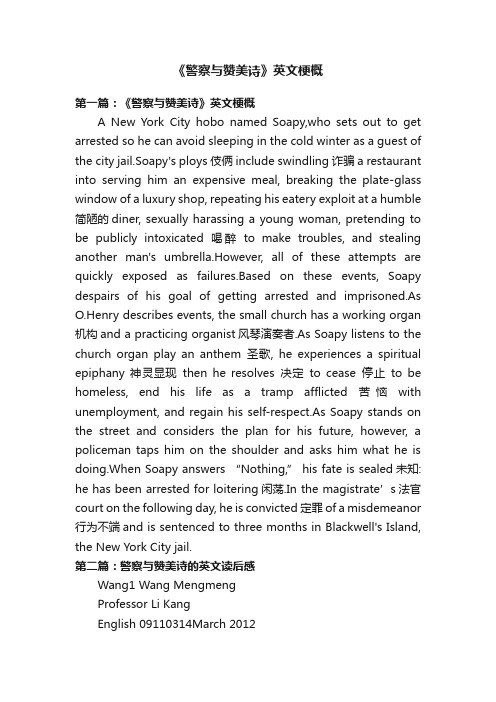
《警察与赞美诗》英文梗概第一篇:《警察与赞美诗》英文梗概A New York City hobo named Soapy,who sets out to get arrested so he can avoid sleeping in the cold winter as a guest of the city jail.Soapy's ploys伎俩include swindling诈骗a restaurant into serving him an expensive meal, breaking the plate-glass window of a luxury shop, repeating his eatery exploit at a humble 简陋的diner, sexually harassing a young woman, pretending to be publicly intoxicated喝醉to make troubles, and stealing another man's umbrella.However, all of these attempts are quickly exposed as failures.Based on these events, Soapy despairs of his goal of getting arrested and imprisoned.As O.Henry describes events, the small church has a working organ 机构and a practicing organist风琴演奏者.As Soapy listens to the church organ play an anthem圣歌, he experiences a spiritual epiphany 神灵显现then he resolves决定to cease停止to be homeless, end his life as a tramp afflicted苦恼with unemployment, and regain his self-respect.As Soapy stands on the street and considers the plan for his future, however, a policeman taps him on the shoulder and asks him what he is doing.When Soapy answers “Nothing,” his fate is sealed未知: he has been arrested for loitering闲荡.In the magistrate’s法官court on the following day, he is convicted定罪of a misdemeanor 行为不端and is sentenced to three months in Blackwell's Island, the New York City jail.第二篇:警察与赞美诗的英文读后感Wang1 Wang MengmengProfessor Li KangEnglish 09110314March 2012The Cop and the AnthemTBased on the whole text, the author's humor is present in various ways, one ofwhich is through irrationality during the development of plots.Soapy, the vagrant who has stirred up trouble for six times, is eager to go to prison.But he is always out of luck and get policeman's forgiveness.When Soapy is touched by the anthem and wants to be a good citizen, he is arrested for groundless reasons.This way is a kind of black humor manifesting social reality profoundly.We can see something gloomy, desperate,but simultaneously, we can't help laughing when reading the vivid description.Once, Soapy wants to reach his goal by molesting a woman, Soapystraightened the lady missionary’s ready-made tie, dragged his shrinking cuffs intothe open, set his hat at a killing cant and sidled toward the young women(20).butthe seeming virtuous and quiet woman begin to seduce him in reverse.“Sure,Mike,” she said joyfully, “if you’ll blow me to a pail of suds.I’d have spoke to yousooner, but the cop was watching.”With the young woman playing the clinging ivyto his oak Soapy(22).Besides, Soapy steals an umbrella from a neatly dressedcustomer, but the umbrella is ill-gotten originally.''Of course,''said the umbrellaWang2man''that is—well, you know how these mistakes occur—I—if it’s your umbrella Ihope you’ll excuse me—I picked it up this morning in a restaurant—If you recogniseit as yours, why—I hope you’ll—''(31).So the modest and lady and gentleman turnout to be someone that we cannot imagine, which is not rational.Nonetheless, as amatter of fact, they just hide their dirty acts under a beautiful veil and a small signcan indicate a great trend, we can learn that the so-called noble upper class goesmore serious than the two.These plots reveals awful mood of that capitalist society.In addition, the conflict between the irrationality of Soapy's behavior and therationality of the cop's judgment is one of the important reasons for Soapy's“misfortune”.For example, Soapy breaks the glass and wait for the policeman tocome and arrest him, but the cop reckons that a man who commits evil won't sitand wait for arrest, men who smash windows do not remain to parley with thelaw’s minions then he excludes Soapy.Besides, he wants to break the peace byvirtue of kicking up a fuss in the street, identically, the cop deems that onlycollege students dare to be so unbridled and boisterous''Tis one of them Yale ladscelebratin’ the goose egg they give to the Hartford College.Noisy;but no harm.We’ve instructions to lave them be.''(25).His abnormal conducts is determined byhis distorted mentality, which exactly reflects torture and agony both in life andmind oft he low-class.When the poor guy intends to do good the moment he ismoved and inspired, the cop believes a vagrant will never something to do withthe quiet atmosphere around a church, the soft lamplight and the touching music.Consequently, Soapy is caught unexpectedly.“What are you doin’ here?” askedthe officer.''Nothing,'' said Soapy(42).''Then come along.''said thepoliceman(43).''Three months on the Island.'' said the Magistrate in the PoliceCourt the next morning.(44).It is the accident that mirrors confusion of truth andfalsehood, black and wright.Needless to say,there are many ways to represent humor, they have one thing incommon--where there is humor, there is specific implication.The writing style of the author is humorous, the disclosure of the society is deepgoing, the reflective life and Wang3mental distress are mirky.O.Henry uses a quantity of comparison and humor to fully display the character's wretched fate and cruelty of capitalist society.Notes1.Jack Frost(Para.2): Jack Frost is a personification of frost.2.Blackwell(Para.5): An island with prisons on East River in New York3.Palm Beach and the Riviera(Para.5): A tourist attraction in winter.4.Cesar(Para.5): A famous statesman, strategist and commander in chief assassinated by Republicans.5.Brutus(Para.5):Roman politician, the chief plotter to assassinate Cesar.6.the choicest products of the grape, the silkworm and the protoplasm(Para.7): It indicates upper-class life.7.brass buttons(Para.5): It refers to policeman, as the fasteners of police uniform are made of brass.Work cited1.2.Henry,O.O Henry 100 Selected Stories [M].Hertfordshire: Wordworth,1995.3.Voss,Arthur.The American Short Story: A Critical Survey[M].Norman:Oklahoma UP,1973:123-1244.田艳.欧亨利短篇小说精选[M].大连:大连理工大学出版社,2005.5.王青松.倪勤.轮欧亨利小说的比喻特色[J].安徽教育学院学报.2006,24(4):82-85.AboutTheAuthorO.Henry is one of the most famous American critical realist short storywriters, and one of the world's top three masters of the short stories.O.Henry'sreal name was William Sydney Porter.O.Henrywas born in Greensboro, North Carolina on September 11,1862.At age of 20(1882)he moved to Texas, where he had various jobs.He married Athol Estes in 1887, in 1894 while working for First National Bank inAustin, Porter was accused of stealing $4000.He went to prison in Columbus,Ohio for 3 years eventually.While in prison Porter first started to write shortstories and believed that he has found his pseudonym there.After Porter wasreleased from the prison in 1901, he changed his name to O.Henry and moved toNew York in 1902.From December 1903 to January 1906 o.Henry wrote a storya week for the New York World magazine, and publishedseveral short stories inother magazines.O.Henry's short stories are famous for their surprise endings, his wit, wordplayand humor.He wrote such classic short stories as The Ransom of Red Chief, TheGift of the Magi, The Furnished Room, The Four Billion, Cabbages and Kings,The Last Leaf, The Cop and the Anthem,etc.In his last years O.Henry had financial and health problems.An alcoholic, O.Henry died on June 5, 1910 in New York City, virtually broke.第三篇:警察与赞美诗《警察与赞美诗》教案澧县职业中专学校皮业书一、作者简介:欧●亨利,美国著名短篇小说家。
美国文学多部作品的翻译及赏析

The wild honey suckle ---- Philip Freneau Fair flower,that dost so comely grow,Hid in this silent,dull retreat,Unseen thy little branches greet;No roving foot shall crush thee here,No busy hand provoke a tear.By Nature's self in whrite arrayed,She bade thee shun the vulger eye,And planted here the guardian shade,And sent soft waters murmuring by;Thus quietly thy summer goes,Thy days declining to repose.Smit with those chams,that must decay,I grieve to see your future doom;they died--nor were those flowers more gay, the flowers that did in Eden bloom;Unpitying frosts,and Autumn's power.Shall leave no vestige of this flower.From morning suns and evening dewsAt first thy little being came:If nothing once,you nothing lose, For when you die you are the same; The space between,is but an hour, The frail duration of flower.美好的花呀,你长得:这么秀丽,却藏身在这僻静沉闷的地方——甜美的花儿开了却没人亲昵,招展的小小枝梢也没人观赏;没游来荡去的脚来把你踩碎,没东攀西摘的手来催你落泪。
the nymph's reply to the shepherd赏析

the nymph's reply to the shepherd赏析《the nymph's reply to the shepherd》是英国诗人安德鲁·马维尔(Andrew Marvell)的一首著名的抒情诗。
这首诗以其精巧的比喻、生动的描绘和丰富的意象而闻名。
首先,这首诗的标题《the nymph's reply to the shepherd》就充满了神秘和吸引力,让人想要一探究竟。
nymph指的是森林女神,而shepherd则通常指代牧羊人。
在诗中,nymph 和shepherd的对话展示了两个截然不同的生活世界的碰撞。
诗的开头,"The fair shepherdess, having flung/ Her sheaves in the sun's eye,"描绘了一个美丽的女神在田野里欢快地劳作的画面,这无疑是对自然和田园生活的赞美。
然而,当牧羊人出现时,整个氛围发生了变化。
牧羊人的到来使得女神感到了不安,"Her blushing shamefastness begun/ To spread a rosy shade/ O'er the crystal spring,"这里运用了生动的比喻,将女神害羞的脸红比作扩散的玫瑰色阴影,形象地描绘了女神在面对牧羊人时的羞涩。
在接下来的部分,女神试图用各种方式来抵抗牧羊人的诱惑。
她将自己封闭在室内,"Strait shut up was the shed/From wanton sun and wooing wind,"这里使用封闭的棚屋象征女神的内心,同时也暗示了她的纯真和自我保护。
然而,牧羊人的热情并没有因此而消退,"The wanton sun and wooingwind/By knotgrass made the shed door fast."这里的"knotgrass"是一种象征坚贞的植物,暗示着女神尽管内心封闭,但仍然无法抵挡牧羊人的热情。
小众情诗英文
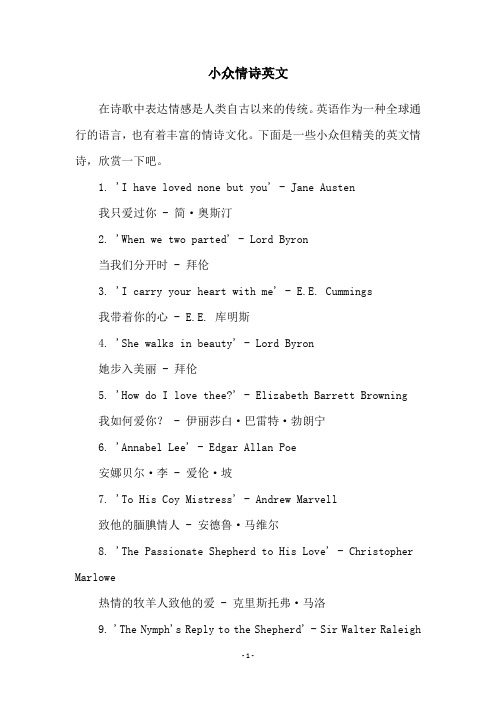
小众情诗英文在诗歌中表达情感是人类自古以来的传统。
英语作为一种全球通行的语言,也有着丰富的情诗文化。
下面是一些小众但精美的英文情诗,欣赏一下吧。
1. 'I have loved none but you' - Jane Austen我只爱过你 - 简·奥斯汀2. 'When we two parted' - Lord Byron当我们分开时 - 拜伦3. 'I carry your heart with me' - E.E. Cummings我带着你的心 - E.E. 库明斯4. 'She walks in beauty' - Lord Byron她步入美丽 - 拜伦5. 'How do I love thee?' - Elizabeth Barrett Browning我如何爱你? - 伊丽莎白·巴雷特·勃朗宁6. 'Annabel Lee' - Edgar Allan Poe安娜贝尔·李 - 爱伦·坡7. 'To His Coy Mistress' - Andrew Marvell致他的腼腆情人 - 安德鲁·马维尔8. 'The Passionate Shepherd to His Love' - Christopher Marlowe热情的牧羊人致他的爱 - 克里斯托弗·马洛9. 'The Nymph's Reply to the Shepherd' - Sir Walter Raleigh女神回复牧羊人 - 沃尔特·罗利爵士10. 'La Belle Dame Sans Merci' - John Keats无情美女 - 约翰·济慈这些小众的英文情诗,不同于经典诗歌的浓烈,但仍然表达了深刻的情感。
希腊神话皮格马利翁中英文对译
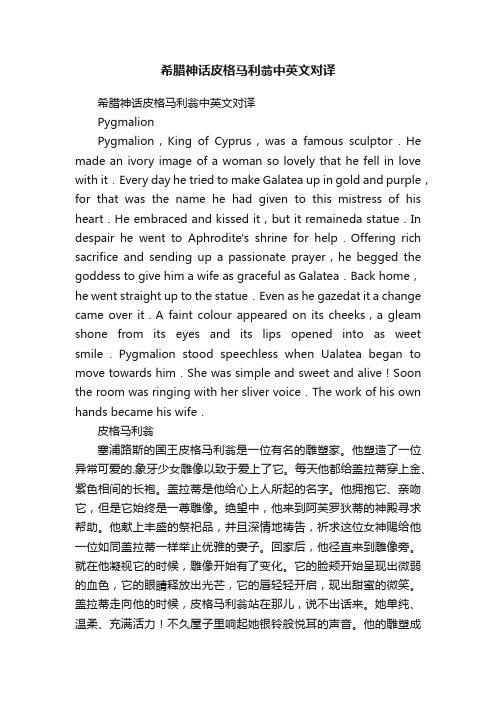
希腊神话皮格马利翁中英文对译希腊神话皮格马利翁中英文对译PygmalionPygmalion,King of Cyprus,was a famous sculptor.He made an ivory image of a woman so lovely that he fell in love with it.Every day he tried to make Galatea up in gold and purple,for that was the name he had given to this mistress of his heart.He embraced and kissed it,but it remaineda statue.In despair he went to Aphrodite's shrine for help.Offering rich sacrifice and sending up a passionate prayer,he begged the goddess to give him a wife as graceful as Galatea.Back home,he went straight up to the statue.Even as he gazedat it a change came over it.A faint colour appeared on its cheeks,a gleam shone from its eyes and its lips opened into as weet smile.Pygmalion stood speechless when Ualatea began to move towards him.She was simple and sweet and alive!Soon the room was ringing with her sliver voice.The work of his own hands became his wife.皮格马利翁塞浦路斯的国王皮格马利翁是一位有名的雕塑家。
the passionate shepherd to his love英语全文
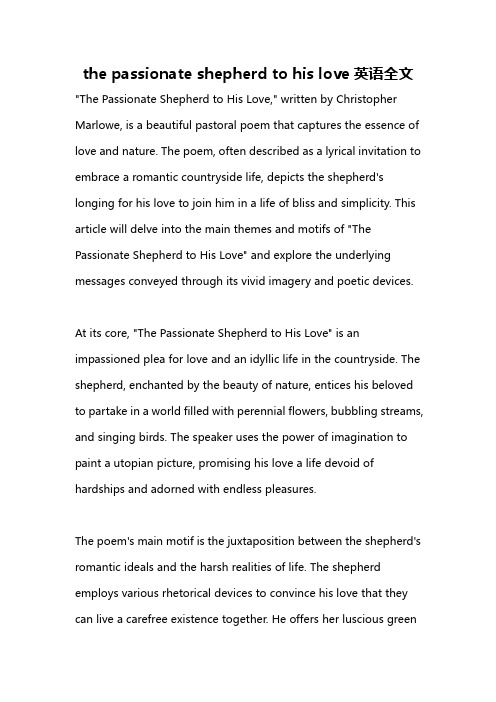
the passionate shepherd to his love英语全文"The Passionate Shepherd to His Love," written by Christopher Marlowe, is a beautiful pastoral poem that captures the essence of love and nature. The poem, often described as a lyrical invitation to embrace a romantic countryside life, depicts the shepherd's longing for his love to join him in a life of bliss and simplicity. This article will delve into the main themes and motifs of "The Passionate Shepherd to His Love" and explore the underlying messages conveyed through its vivid imagery and poetic devices.At its core, "The Passionate Shepherd to His Love" is an impassioned plea for love and an idyllic life in the countryside. The shepherd, enchanted by the beauty of nature, entices his beloved to partake in a world filled with perennial flowers, bubbling streams, and singing birds. The speaker uses the power of imagination to paint a utopian picture, promising his love a life devoid of hardships and adorned with endless pleasures.The poem's main motif is the juxtaposition between the shepherd's romantic ideals and the harsh realities of life. The shepherd employs various rhetorical devices to convince his love that they can live a carefree existence together. He offers her luscious greenvalleys, silver rivers, and beds of roses as symbols of a life where pleasure and comfort reign supreme. However, the poem's repetitive refrain, "Come live with me and be my love," hints at the speaker's desperation to persuade his beloved, revealing a fundamental insecurity underlying the shepherd's promises.Despite its apparent beauty, "The Passionate Shepherd to His Love" has often been criticized for its idealistic portrayal of love and nature. Some argue that the poem romanticizes pastoral life, glossing over the difficulties and hardships that accompany such a lifestyle. The shepherd's invitation can be viewed as naive and unrealistic, presenting an idyllic fantasy rather than a sustainable reality. Others have argued that the shepherd's love is more infatuation than true devotion, and his promises lack the depth necessary for a lasting relationship.However, it is important to note that the poem must be understood within its context. Written during the Elizabethan era, a time characterized by courtly love and an idealized portrayal of the countryside, "The Passionate Shepherd to His Love" reflects the prevailing literary conventions of the time. Romanticizing nature and cultivating an image of the pastoral paradise were widelyaccepted notions in Renaissance literature. Consequently, viewing the poem as a product of its time helps shed light on its intended purpose and tone."The Passionate Shepherd to His Love" is also renowned for its rich use of imagery and poetic devices. Marlowe effectively employs metaphors and similes to create a sensory experience for the reader. For instance, the shepherd compares his love's eyes to the "daisies pied," implying that her eyes are as beautiful and captivating as flowers. Additionally, the poet uses alliteration and assonance to enhance the musicality of the poem, adding to its lyrical quality. Through these poetic techniques, Marlowe creates a vivid landscape that entices the reader to embrace the shepherd's idyllic vision.In conclusion, "The Passionate Shepherd to His Love" is a captivating poem that evokes both a longing for love and a yearning for the pleasures of nature. While its idealized portrayal of rural life may be seen as unrealistic by some, it is important to appreciate the poem within its historical context. Through vivid imagery and poetic devices, Marlowe invites readers into a world ofbeauty and simplicity, prompting them to contemplate love, nature, and the timeless human desire for an idyllic existence.。
双语诗歌:TheNymph’sReplytotheShepherd仙女对牧羊人的回答
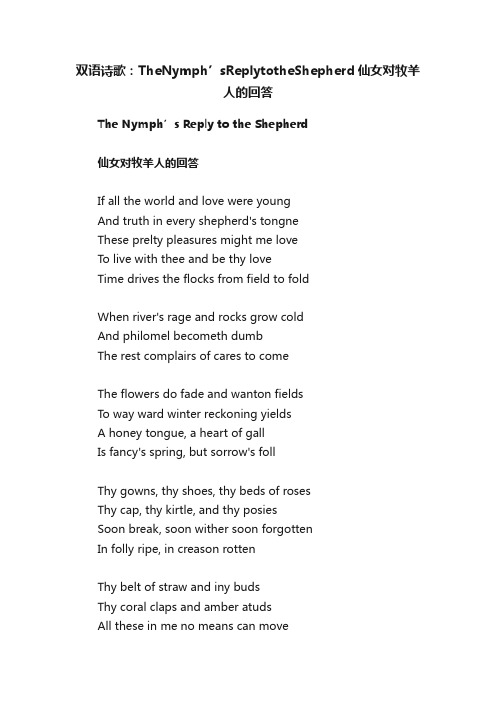
双语诗歌:TheNymph’sReplytotheShepherd仙女对牧羊人的回答The Nymph’s Reply to the Shepherd仙女对牧羊人的回答If all the world and love were youngAnd truth in every shepherd's tongneThese prelty pleasures might me loveTo live with thee and be thy loveTime drives the flocks from field to foldWhen river's rage and rocks grow coldAnd philomel becometh dumbThe rest complairs of cares to comeThe flowers do fade and wanton fieldsTo way ward winter reckoning yieldsA honey tongue, a heart of gallIs fancy's spring, but sorrow's follThy gowns, thy shoes, thy beds of rosesThy cap, thy kirtle, and thy posiesSoon break, soon wither soon forgottenIn folly ripe, in creason rottenThy belt of straw and iny budsThy coral claps and amber atudsAll these in me no means can moveTo come to thee and bethy loveBut could youth last, and love still breed Had joys no date, nor age no need Then these delights my mind might move To live with thee and be thy love.假如整个世界和爱情永驻青春每一个牧羊人的誓言句句真诚这些美妙的欢乐便会打动我的心房来和你你起生活,做你的新娘黄昏逐着羊群从田野进了羊栏河水开始咆哮,岩石变的冰冷夜莺停止歌唱沉默不语安宁抱怨起悄然袭来的忧虑花儿会凋落,诱人的田野也一样屈从于冬天,它的变幻无常甜蜜的舌头,一颗冷酷的心是幻想的喷泉,却把痛苦降临你的新袍,新鞋,和玫瑰花床你的花冠,裙裾,和鲜花芬芳瞬间便消失,褪萎,被忘怀愚蠢的成熟,注定得早衰你的草杆腰带,青藤编的束珊瑚的别针,琥珀做的扣环这一切都不能打动我的心房走到你的身边去,做你的新娘可只要青春常在,爱能得到滋润只要愉悦无穷,岁月永恒这样的欢乐就会打动我的心房来和你一起生活做你的新娘。
TheNymphSReplytotheShepherd
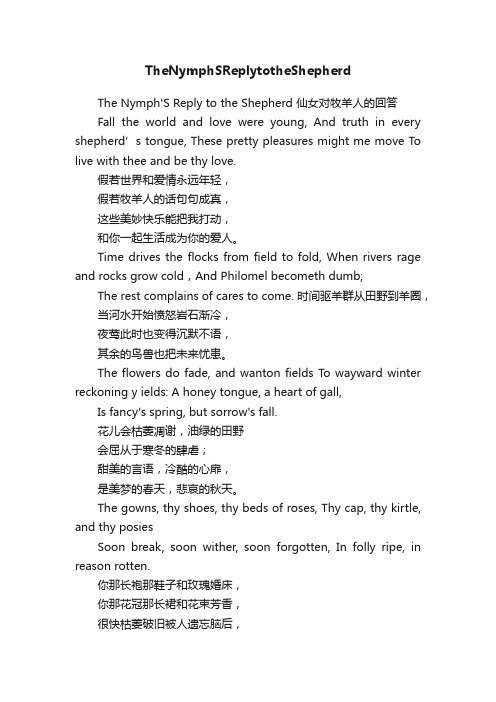
TheNymphSReplytotheShepherdThe Nymph'S Reply to the Shepherd 仙女对牧羊人的回答Fall the world and love were young, And truth in every shepherd’s tongue, These pretty pleasures might me move T o live with thee and be thy love.假若世界和爱情永远年轻,假若牧羊人的话句句成真,这些美妙快乐能把我打动,和你一起生活成为你的爱人。
Time drives the flocks from field to fold, When rivers rage and rocks grow cold,And Philomel becometh dumb;The rest complains of cares to come. 时间驱羊群从田野到羊圈,当河水开始愤怒岩石渐冷,夜莺此时也变得沉默不语,其余的鸟兽也把未来忧患。
The flowers do fade, and wanton fields To wayward winter reckoning y ields: A honey tongue, a heart of gall,Is fancy's spring, but sorrow's fall.花儿会枯萎凋谢,油绿的田野会屈从于寒冬的肆虐;甜美的言语,冷酷的心扉,是美梦的春天,悲哀的秋天。
The gowns, thy shoes, thy beds of roses, Thy cap, thy kirtle, and thy posiesSoon break, soon wither, soon forgotten, In folly ripe, in reason rotten.你那长袍那鞋子和玫瑰婚床,你那花冠那长裙和花束芳香,很快枯萎破旧被人遗忘脑后,它们在痴想中长成,在理想中消亡。
- 1、下载文档前请自行甄别文档内容的完整性,平台不提供额外的编辑、内容补充、找答案等附加服务。
- 2、"仅部分预览"的文档,不可在线预览部分如存在完整性等问题,可反馈申请退款(可完整预览的文档不适用该条件!)。
- 3、如文档侵犯您的权益,请联系客服反馈,我们会尽快为您处理(人工客服工作时间:9:00-18:30)。
克里斯托弗·马洛Christopher Marlowe(1564—1593),英国诗人,剧作家。
在剑桥大学获硕士学位。
马洛革新了中世纪的戏剧,共写了七部剧本,其中塑造的时代巨人形象及其无韵体诗剧形式对莎士比亚等作家产生了很大影响,是英国近代戏剧的奠基者。
他翻译了三卷奥维德的《爱情诗》,写了少量抒情短诗。
可惜这一巨匠却英年早逝于一场酒吧斗殴。
无婚史。
The Passionate Shepherd to His loveCome live with me and be my love,And we will all the pleasures proveThat valleys, groves, hills, and field,Woods, or steepy mountain yields.And we will sit upon the rocks,Seeing the shepherds feed their flocks,By shallow rivers to whose fallsMelodious birds sing madrigals.And I will make thee beds of rosesAnd a thousand fragrant posies,A cap of flowers, and a kirtleEmbroidered all with leaves of myrtle;A gown made of the finest woolWhich from our pretty lambs we pull;Fair lined slippers for the cold,With buckles of the purest gold;A belt of straw and ivy buds,With coral clasps and amber studs:And if these pleasures may thee move ,Come live with me and be my love.The shepherds’ swains shall dance and singFor thy delight each May morning:If these delights thy mind may move,Then live with me and be my love.注:1.And we will all the pleasures prove ...yields: And we will prove all the pleasures that valleys...yields( brings about).生产;获利2.falls:瀑布;落下,此处指溪水流淌中形成的水落。
3.madrigals: 合唱歌曲4. posies:花朵,花束5. kirtle:. 女装或外裙6.Embroider:刺绣7. myrtle:桃金娘科植物8.lined: 垫过内衬的9.buckles:环扣10.buds:苞;芽10.claps:扣钩,扣环11.studs:(衣袖等)饰钮12.swains:求爱者;乡村情郎汉语七言译诗羊倌致恋人君来嫁我伴终生,美景良辰共销魂,峡谷果园村野秀,山峦陡峻层林幽。
两情相悦坐岩边,遥望羊倌放牧闲,清浅碧流水落急,莺声宛转伴鸣溪。
我洒玫瑰舖婚床,万千花束吐芬芳,再织花冠配花裙,桃金娘叶作绣锦。
上等羊毛织秀袍,羊毛剪自俏羊羔;带衬拖鞋御严寒,纯金镶嵌做扣环。
麦草藤萝腰带柔,琥珀饰纽珊瑚扣,此情若可动心魂,盼君嫁我度今生。
五月清晨多欢乐,放牧情郎舞且歌,无边欢乐若摄魂,君来嫁我度今生。
(峨以译)诗歌赏析多情的牧羊人用充满诗意的语言,描绘了想像中和心上人一起度过幸福的田园生活,展现着年轻的生命对真挚爱情的渴望。
诗人对大自然的美好存在及给心上人的所有馈赠极尽细腻的描写,语言清新,意象丰富,使诗歌充溢着浓烈的乡村风情。
此诗为四音步抑扬格双韵诗体,共六节每节四句。
沃特·雷利Walter Raleigh(1554-1618)英国诗人、军人、政客、探险家,历史学家、科学家。
他勇敢高尚,英俊潇洒,彬彬有礼,曾被女王封为骑土,可惜后被诬陷叛国罪而入狱13年,并被砍头。
雷利一生中写过许多诗歌,大多以手稿形式流传在外。
他的诗歌多为抒情短诗,其特点是在彼特拉克式的爱情主题中,掺入自己对人类生活环境的思考,常常发出对生命无常和时光短暂的感慨。
雷利与妻子感情非常好。
The Nymph's Reply to the ShepherdIf all the world and love were young,And truth in every shepherd’s tongue,These pretty pleasures might me moveTo live with thee and be thy love.Time drives the flocks from field to fold,When rivers rage and rocks grow cold,And Philomel becometh dumb;The rest complains of cares to come.The flowers do fade, and wanton fieldsTo wayward winter reckoning yields:A honey tongue, a heart of gall,Is fancy's spring, but sorrow's fall.The gowns, thy shoes, thy beds of roses,Thy cap, thy kirtle, and thy posiesSoon break, soon wither, soon forgotten,In folly ripe, in reason rotten.Thy belt of straw and ivy buds,Thy coral clasps and amber studs,All these in me no means can moveTo come to thee and be thy love.But could youth last and love still breed,Had joys no date nor age no need,Then these delights my mind might moveTo live with thee and be thy love.注:1.Nymph是希腊神话中次要的女神,善歌舞。
她们不会衰老或生病,但会死去。
2. fold:羊栏;畜栏3. Philomel: 夜莺4. becometh:becomes的古体。
5. cares:忧虑6. wanton:繁茂的7. To wayward winter reckoning yields:wayward,任性的,意料不到的;reckoning,可以猜想到的;yields,屈服,投降8.gall:怨恨;苦味9. folly: 愚行10.All these in me no means can move:倒装句,原句为All these can (by)no means move in me.11. But could youth last and love still breed:虚拟语气所用的倒装,原句为But if youth could last...,原文中多处用了此种句式;still:always;breed:产(后代),生产12.need:短缺,缺乏汉语七言译诗仙女致羊倌凡尘情爱倘年轻,羊倌海口若能信,良辰美景撼心魂,我便嫁君度此生。
向晚野归羊入栏,激流咆哮岩石寒,夜莺缄口不开怀,安逸消失忧患来。
百花烂漫终凋谢,沃野忍从冬肆虐,人前蜜语心诈伪,春梦神奇秋月悲。
披袍着履花床眠,帽新裙艳花束鲜,一朝凋败速遗忘,生就愚蒙亡理想。
麦草藤萝腰带秀,珊瑚环扣琥珀纽,俗物安得慰我魂,与君苟且度残生?青春久远爱长驻,极乐常存无尽处,良缘天赐夺心魂,我便嫁君度此生!(峨以译)诗歌赏析这首诗是雷利对同时代英国剧作家克里斯托弗·马洛所作The Passionate Shepherd to His love一诗的回应,来表达对爱情、对人生的不同思考。
马洛描写的是诗人对美丽姑娘山盟海誓的追求,而雷利却借有寿限女神Nymph之口对牧羊人说,你描绘了身边许多美好的事物,却无视生活的艰辛,而且,你不能给我永恒的青春和爱情!此诗为四音步抑扬格双韵诗体,共六节每节四句。
诗歌选辑(二)The Silent LoverPassions are liken'd best to floods and streams :The shallow murmur, but the deep are dumb ;So, when affection yields discourse it seemsThe bottom is but shallow whence they come.They that are rich in words, in words discoverThat they are poor in that which makes a lover.注:1.liken’d:比拟,把......比作 2.yields:屈服;退让3. discourse: 交谈 4.but: except 5.whence:从何处,从哪里,此处作连词引导一个地点状语从句。
6. They that are rich......: that这里相当于who。
汉语七言译诗沉默恋人激情堪比湍急溪,水面喧腾深处静;激情一经化言语,但见心底浅薄情。
甜言蜜语情不真,其实不配做恋人。
(峨以译)诗歌赏析这首短诗选自雷利所作The Silent Lover两首诗中的第一首。
诗人采用了象征性写法,把人比做溪流。
许多人就是那样表里不一,动听的话语,贫乏的内心,这样的人不值得你去爱。
此诗为五音步抑扬格,韵律为ABABCC。
